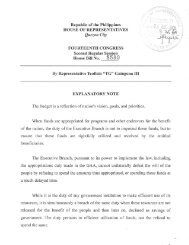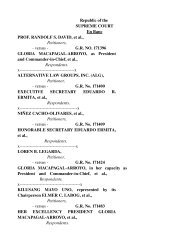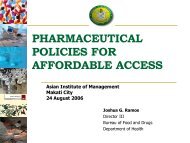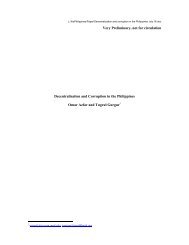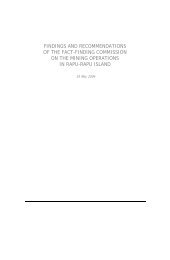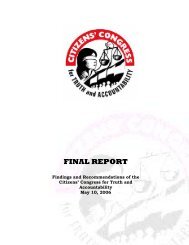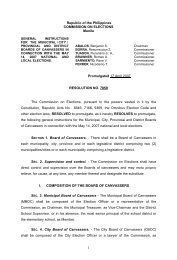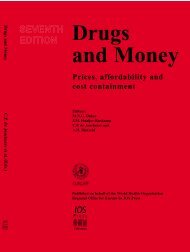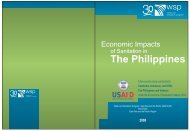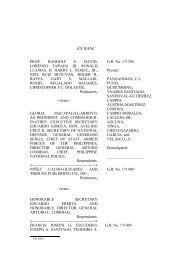The state of water resources in the Philippines - Greenpeace
The state of water resources in the Philippines - Greenpeace
The state of water resources in the Philippines - Greenpeace
You also want an ePaper? Increase the reach of your titles
YUMPU automatically turns print PDFs into web optimized ePapers that Google loves.
e found <strong>in</strong> <strong>the</strong> <strong>in</strong>test<strong>in</strong>al tracts <strong>of</strong> warm-blooded animals, and <strong>in</strong> plants, soil, air,<br />
and <strong>the</strong> aquatic environment. Fecal coliforms are those coliforms found <strong>in</strong> <strong>the</strong><br />
feces <strong>of</strong> various warm-blooded animals.<br />
Effluent - discharges from known sources passed <strong>in</strong>to a body <strong>of</strong> <strong>water</strong> or land, or<br />
waste<strong>water</strong> flow<strong>in</strong>g out <strong>of</strong> a manufactur<strong>in</strong>g or <strong>in</strong>dustrial plant, or from domestic,<br />
commercial and recreational facilities<br />
Fresh<strong>water</strong> - <strong>water</strong> conta<strong>in</strong><strong>in</strong>g less than 500 ppm dissolved common salt,<br />
sodium chloride, such as that <strong>in</strong> ground<strong>water</strong>, rivers, ponds, and lakes<br />
Ground<strong>water</strong> - a subsurface <strong>water</strong> that occurs beneath a <strong>water</strong> table <strong>in</strong> soils and<br />
rocks, or <strong>in</strong> geological formations<br />
Ground<strong>water</strong> recharge - <strong>in</strong>flow to a ground<strong>water</strong> reservoir<br />
Ground<strong>water</strong> reservoir - an aquifer or aquifer system <strong>in</strong> which ground<strong>water</strong> is<br />
stored. <strong>The</strong> <strong>water</strong> may be placed <strong>in</strong> <strong>the</strong> aquifer by artificial or natural means.<br />
Hydrologic cycle - natural pathway <strong>water</strong> follows as it changes between liquid,<br />
solid, and gaseous <strong>state</strong>s. This biogeochemical cycle moves and recycles <strong>water</strong><br />
<strong>in</strong> various forms through <strong>the</strong> ecosphere. (Also called <strong>the</strong> <strong>water</strong> cycle.)<br />
Indicator organisms - microorganisms, such as coliforms, whose presence is<br />
<strong>in</strong>dicative <strong>of</strong> pollution or <strong>of</strong> more harmful microorganisms<br />
Leachate - <strong>water</strong> conta<strong>in</strong><strong>in</strong>g contam<strong>in</strong>ants which leaks from a disposal site such<br />
as a landfill or dump.<br />
Non-po<strong>in</strong>t source - any source <strong>of</strong> pollution not identifiable as po<strong>in</strong>t source to<br />
<strong>in</strong>clude, but not be limited to, run<strong>of</strong>f from irrigation or ra<strong>in</strong><strong>water</strong> which picks up<br />
pollutants from farms and urban areas<br />
Per Capita Water Availability (per year) - <strong>water</strong> available per person per year<br />
Po<strong>in</strong>t source - any identifiable source <strong>of</strong> pollution with specific po<strong>in</strong>t <strong>of</strong> discharge<br />
<strong>in</strong>to a particular <strong>water</strong> body<br />
Receiv<strong>in</strong>g Water - a river, stream, lake, ocean, or o<strong>the</strong>r surface <strong>of</strong> ground<strong>water</strong><br />
<strong>in</strong>to which treated or untreated waste<strong>water</strong> is discharged<br />
Recharge - refers to <strong>water</strong> enter<strong>in</strong>g an underground aquifer through faults,<br />
fractures, or direct absorption<br />
Renewable Resource - resource that potentially cannot be used up because it is<br />
constantly or cyclically replenished<br />
Reservoir - a pond, lake, tank, or bas<strong>in</strong> (natural or human-made) where <strong>water</strong> is<br />
collected and used for storage. Large bodies <strong>of</strong> ground<strong>water</strong> are called<br />
ground<strong>water</strong> reservoirs; <strong>water</strong> beh<strong>in</strong>d a dam is also called a reservoir <strong>of</strong> <strong>water</strong>.<br />
River bas<strong>in</strong> - area dra<strong>in</strong>ed by a river and its tributaries. A pr<strong>in</strong>cipal river bas<strong>in</strong><br />
has a dra<strong>in</strong>age area <strong>of</strong> at least 40 km 2 , while a major river bas<strong>in</strong> has a dra<strong>in</strong>age<br />
area <strong>of</strong> more than 1,400 km 2 .<br />
Run<strong>of</strong>f - surface <strong>water</strong> enter<strong>in</strong>g rivers, fresh<strong>water</strong> lakes, or reservoirs<br />
GREENPEACE | <strong>The</strong> <strong>state</strong> <strong>of</strong> <strong>water</strong> <strong>in</strong> <strong>the</strong> Philipp<strong>in</strong>es 6



